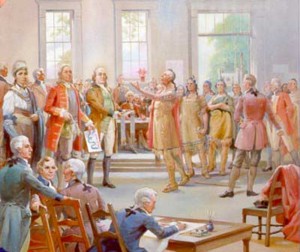what inspired delegates to meet in the summer of 1754?
by
Stefan Bielinski

The Albany Congress met in Albany from June 19 to July 11, 1754. Holding daily meetings at the City Hall, official delegates from seven colonies considered strategies for Indian diplomacy and put forth the and then-called Albany Plan of Union.
Unsure of its authority to participate, the province of New York sent only an unofficial delegation which included Lieutenant Governor James De Lancey and two men with stiff Albany connections, William Johnson and Peter Wraxall. The Mohawks and other Native groups were represented at the meetings likewise. Livingston son-in-constabulary William Alexander also attended representing his bilious male parent.
Aside from its overall significance, the Albany Congress was a not unimportant result in the history of Albany. The Albany meeting site pointed upwards Albany'south part equally the concluding outpost of European-style civilization before the frontier - a place where settlers, officials, and native peoples had and would continue to come up together to consider matters of mutual concern. Amid the agendas for the convention, was a programme to replace provincial Indian Commissioners with a Royal Superintendent of Indian Diplomacy - which was aimed straight at the Albany Indian commissioners who were seen by the British as self-interested merchants whose cadre ambitions were antagonist to Imperial policy.
The meetings brought Benjamin Franklin and other important Americans to Albany - opening up the inland community to the outside earth. The trip was instructive for many of these colonial leaders. Over a month of intensive activeness, the convention gave notoriously insular Albany people ranging from mayor Robert Sanders and the city fathers to the rank and file denizens their outset prolonged contact with other Americans whose cultural heritage was substantially unlike from their own. For all concerned, the summer of 1754 provided images and lessons that many of them would not forget.
With the burning of Hoosick just a month later past Canada based raiders triggering the resumption of overt hostilities between the forces of France and Great britain delegates, British officials, native peoples, and everyone in Albany itself had already been accorded a wake-upward call to the dangers of unpreparedness and inaction. A long war would follow.
The Albany Congress has been accorded its place in most standard American history books and in near all the historical accounts of the history of Albany. It also has been the field of study of two major monographic studies. Different most of the heritage-inspired narratives, these scholarly works brainstorm to identify the upshot[due south] in some rational perspective!
Sources: Robert C. Newbold, The Albany Congress and the Program of Union of 1754 (Vantage Press of New York, 1955), a cocky-published only nonetheless solid political/diplomatic narrative. Timothy J. Shannon, Crossroads of Empire; Indians, Colonists, and the Albany Congress of 1754 (Cornell Academy Press, 2000), a social history of the convention and a reinterpretation of its significance. The then existing published articles are noted in these works. Outset with its Wikipedia entry, the event has and continues to inspire a voluminous and multi-layered print and online exposition.
Detail from a set of iv thematic murals (each with three historical sub-scenerios) painted by David C. Lithgow for display at the New York World's Fair in 1939. Those murals are in the collection of the New York Land Museum. Other modern renderings of the historic conclave are depicted online.
History of this item: A few months following the initial launch of this spider web hazard late in 1999, we received a number of enquiries from members of a (momentarily forgotten but out-of-land) simple schoolhouse social studies class asking questions about the Albany Congress. Later the beginning batch of these queries (thankfully all received before I could reply to them individually), I decided to create a webpage on this major signal of interest for the history of early Albany. At that time, the existing web-based offerings were sparse and skeletal. From information technology we learned that the Internet offered great promise in our driving goal to present the story of the people of colonial Albany and their world to diverse and wide-ranging audiences. Hundreds of people viewed the page it the first month. Adjacent, the and so existing online presentations were wholly inadequate in terms of reliably relating the story and also would non exist very useful to u.s.a. as they had essentially ignored the early Albany context. Looking dorsum on the Congress (and on the subsequent scholarship), I suspect that our unique contribution to the topic comes with our ongoing work on the customs context (mayhap stage) for the month long upshot and with our ability to work with Tim Shannon during the early stages of became a pretty satisfying monograph. Notwithstanding, we promise to be able to link the people of colonial Albany more than to that issue in the hereafter. The Loudoun demography of 1756 provides a handy roster of those involved on the Albany side.
Follow this link to more than well-nigh the Congress on this website.
Province of New York: The eastern office of the entity that became New York State in 1776 existed in several of geopolitical incarnations later on it ceased to be New Netherland in 1664. Past the 1750s, it was a regal province and part of the worldwide British Empire. This link introduces a traditional approach to the general topic. A simple Google search under New York Colony provides access to several generations of scholarship of all degrees of usefulness (a polite word) that I personally have constitute less and less useful as the concluding four decades have unfolded. My advice for learning about this region (all of New York) in that fourth dimension (until and through the Revolutions) is to focus on a topic and/interest and learn about it from the bottom up and from the inside out - or otherwise "on its ain terms."
beginning posted 10/3/00; updated eight/31/15
Source: https://exhibitions.nysm.nysed.gov/albany/albanycongress.html
0 Response to "what inspired delegates to meet in the summer of 1754?"
Post a Comment